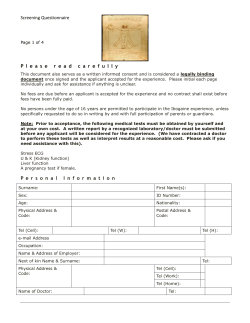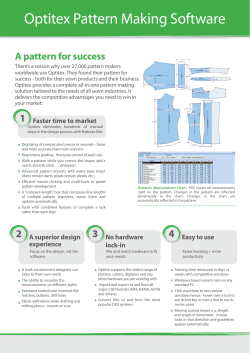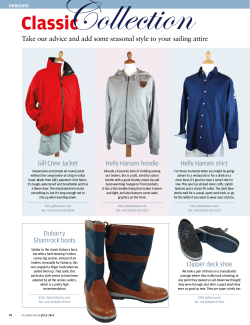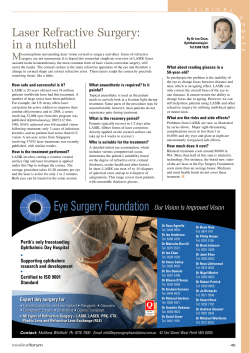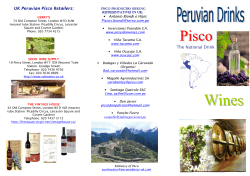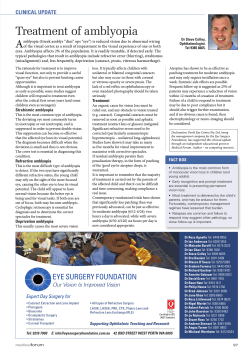
International Workshop EPPO/CoE/ IUCN ISSG How to communicate on pests and invasive
EPPO/CoE/ IUCN ISSG International Workshop How to communicate on pests and invasive alien plants? Oeiras (PT), 2013-10-08/10 Programme Description of thematic workshops Abstracts List of participants 2 EPPO/CoE/ IUCN ISSG International Workshop How to communicate on pests and invasive alien plants? Oeiras (PT), 2013-10-08/10 Table of contents Programme ........................................................................................ 3 Thematic workshops ............................................................................. 9 Thematic Workshop 1.1 What do you expect from EPPO and international organizations? ..................... 10 Thematic Workshop 1.2 How to communicate on the new European legislative proposal, and how to involve stakeholders and the general public? ...................................................... 11 Thematic Workshop 1.3 Communicating on invasive plants and pests with a media audience ................. 12 Thematic Workshop 2.1 Social communication: its linguistic and anthropological dimensions ................ 14 Thematic Workshop 2.2 How to strategically target your message? ................................................ 15 Thematic workshop 2.3 How to communicate on invasive alien species in countries with a low level of awareness?...................................................................................... 16 Thematic Workshop 3.1 Dos and Don’t .................................................................................. 17 Thematic Workshop 3.2 How to elaborate a press communiqué? ................................................... 18 Thematic Workshop 3.3 Incorporating the general population into the management of ecosystems impacted by invasive alien species ..................................................................... 19 Thematic Workshop 4.1 How to convey positive messages to the horticulture industry? ....................... 20 1 Thematic Workshop 4.2 How to develop an awareness campaign on pest and invasive alien plants for an international exhibition or event? .......................................................... 21 Thematic Workshop 4.3 Can ‘hands-on’ activities be an effective tool to engage people with IAPs problem and change behaviors? ........................................................................ 22 ‘Invasive alien plants clean up afternoon’ ................................................. 23 List of participants .............................................................................. 25 2 EPPO/CoE/ IUCN ISSG International Workshop How to communicate on pests and invasive alien plants? Programme Oeiras (PT), 2013-10-08/10 Tuesday 8th of October 8:00-8:30: Registration and welcome of the participants 8:30-9:00: Opening of the workshop and welcome from Ringolds Arnitis, Director General of EPPO, Eladio Fernandez-Galiano, Head of the Biodiversity Unit, Council of Europe, Piero Genovesi, Chair of the IUCN Invasive Species Specialist Group, Maria Teresa Villa de Brito, Director General of DGAV, Helena Freitas, Coordinator of Centre for Functional Ecology and vice-rector of the University of Coimbra. Session 1: How international institutions communicate on pests and invasive alien plants? Chaired by Ringolds Arnitis, European and Mediterranean Plant Protection Organization 9:00-9:20: EPPO activities on communication on pests including invasive alien plants Anne-Sophie Roy and Sarah Brunel, European and Mediterranean Plant Protection Organization (EPPO) 9:20-9:40: Bern Convention activities: voluntary Codes of conduct for botanic gardens and horticulture and engagement with the public Vernon Heywood, School of Biological Sciences, University of Reading 09:40-10:00: Asia-Pacific Forest Invasive Species Network (APFISN): Accomplishments made on raising awareness on invasive species Kavileveettil Sankaran, Kerala Forest Research Institute, India 3 10:00-10:15: Seven years’ experience in Plant Health at the European Food Safety Authority (EFSA) Sara Tramontini and Olaf Mosbach-Schulz, European Food Safety Authority 10:15-10:30: The European Environment Agency work with IAS: from expert reports to citizen science Paco Sánchez-Aguado, European Environment Agency 10:30-10:45: International trade and invasive alien species Kenza Le Mentec, Standard and Trade Development Facilities, World Trade Organization (WTO) 10:45-11:00: IUCN/ISSG communication activities on alien species Riccardo Scalera, IUCN Invasive Species Specialist group 11:00-11:20: Coffee break 11:20-12:30: Thematic workshops - 1.1. What do you expect from EPPO and international organizations? Chaired by Ringolds Arnitis and Anne-Sophie Roy, European and Mediterranean Plant Protection Organization (EPPO) - 1.2. How to communicate on the new European legislative proposal, and how to involve stakeholders and the general public? Chaired by Piero Genovesi and Riccardo Scalera, IUCN Invasive Species Specialist group - 1.3. Communicating on invasive plants and pests with a media audience. Chaired by Sophie Claudet, journalist and communications consultant 12:30-14:00: Lunch Session 2: Difficulties in communicating on pests and invasive alien plants: the need for interdisciplinarity Chaired by Piero Genovesi, IUCN Invasive Species Specialist group 14:00-14:20: Coping with pests and invasive alien species: the actors, their categorizations and the communication issue Frank Alvarez-Pereyre, Centre national de la recherche scientifique, France 14:20-14:40: Mimosa freak show - A presentation on the acacia propaganda (and antipropaganda) in Portugal Manuel Fernandes, Centro de Estudios de Geografia e Ordenamento do Território, Faculdade de Letras, Universidade do Porto, Portugal 14:40-15:00: Communication on IAS issues to media José Manuel Fernandez 15:00-15:20: Developing your message: five points to consider Jamie Reaser, Congruence, LLC, USA 15:20-15:40: Needs and barriers to effective IAS communication in the developing world Arne Witt, CABI 4 15:40-16:00: Different media for different audiences in a diverse society Alex Marsh, South African National Biodiversity Institute, South Africa 16:00-16:20: Coffee break 16:20-18:30: Thematic workshops - 2.1. Social communication: linguistic and anthropological dimensions, Chaired by Franck Alvarez-Pereyre, Centre national de la recherche scientifique and Sarah Brunel, European and Mediterranean Plant Protection Organization (EPPO) - 2.2. How to strategically target your message? Chaired by Jamie Reaser, Congruence LLC, USA - 2.3. How to communicate on invasive alien species in countries with a low level of awareness? Chaired by Necmi Aksoy, Duzce University, Faculty of Forestry, Department of Forest Botany & DUOF Herbarium, Duzce (15 min presentation) and Arne Witt, CABI Wednesday 9th of October Session 3: Experiences that worked, experiences that did not work Chaired by Carlos São Simão de Carvalho, Direção Geral de Alimentação e Veterinária de Serviços de Sanidade Vegetal, Portugal 9:00-9:15: Forest Invaders – the outcomes of a project about invasive species inside and outside the classroom Hélia Marchante, Universidade de Coimbra, Escola Superior Agrária/Instituto Politécnico de Coimbra, Portugal 9:15-9-30: Examples of communication on pests by the German plant protection organization Katrin Kaminski, Julius Kuehn-Institute (JKI), Germany 9:30-9:45: Experience from two awareness raising projects on alien species in Slovenia Jana Kus Veenvliet, Institute Symbiosis, Slovenia 9:45-10:00: The importance of field-work projects on increasing public awareness about invasive species: a case study in Portugal Maria Morais, Universidade de Coimbra, Portugal 10:00-10:15: Invasive species management coordination in the Loire catchment area Stéphanie Hudin, Fédération des conservatoires d'espaces naturels, France 10:15-10:30: Communication: the fastest growing part of the management of plant invasions in Saxony-Anhalt, Germany Katrin Schneider, Centre for Invasive Plants in protected areas of Saxony-Anhalt at UfU, Germany 10:30-10:45: Use of complementary tools to optimize awareness Céline Fontaine, Centre Permanent d'Initiatives pour l'Environnement du Val d'Authie, France 10:45-11:00: Japanese knotweed, journalism and Joe Public Dick Shaw, Regional Coordinator for Invasive Species, CABI 5 11:00-11:10: Coffee break 11:10-12:30: Thematic workshops - 3.1. Dos and Don’t, Chaired by Katrin Schneider, Centre for Invasive Plants in protected areas of Saxony-Anhalt at UfU, Germany and Olaf Booy, GB Non-Native Species Secretariat - 3.2. How to elaborate a press communiqué? Chaired by José Manuel Fernandez and Eladio Fernandez-Galiano, Council of Europe - 3.3. Incorporating the general population into the management of ecosystems impacted by invasive alien species. Chaired by Judy Fisher, Fisher Research. 12:30-14:00: Lunch Buffet 14:00-18:00: ‘Invasive alien plants clean up afternoon’ The workshop participants will have the opportunity to help controlling some invasive alien plants in a protected area. 20:00-23:00: Official dinner of the workshop at the kind invitation of Direção Geral de Alimentação e Veterinária de Serviços de Sanidade Vegetal (DGAV) Thursday 10th of October Session 4: Adapting the message to different stakeholders and citizen sciences Chaired by Eladio Fernandez-Galiano, Council of Europe 9:00-9:15: The Code of conduct on invasive plants in Belgium: results after two years of communication with the horticultural sector Mathieu Halford, Biodiversity & Landscape Unit, University of Liège Gembloux Agro-Bio Tech, Belgium 9:15-9:30: Working with the horticulture industry to limit invasion risks: the Swiss experience Franziska Humair, Institute for Environmental Decisions – Consumer Behavior, ETH Zurich, Switzerland 9:30-9:45: Do code-of-conducts increase public awareness and engagement in problems with invasive aquatic plants? Laura Verbrugge, Radboud University Nijmegen, Institute for Science, Innovation and Society, Department of Philosophy and Science Studies, Nijmegen, the Netherlands 9:45-10:00: Israel's least wanted alien ornamental plant species Jean-Marc Dufour-Dror, Consultant to the Israel Nature & Parks Authority, Israel 10:00-10:15: New elements in the monitoring of invasive alien plants in the Czech Republic Martina Sojneková, State Phytosanitary Administration, Czech Republic 6 10:15-10:30: Public awareness: a useful tool for the early detection and a successful eradication of the Longhorned Beetles Mariangela Ciampitti, Italian Plant Protection Organization, Italy 10:30-10:45: Warning network for detection of new invasive alien species in Reunion Island Catherine Julliot, Direction de l'Environnement, de l'Aménagement et du Logement de La Réunion, France 10:45-11:00: Mapping invasive plants in Portugal: involving the public and promoting awareness Elizabete Marchante, Universidade de Coimbra, Portugal 11:00-11:20: Coffee break 11:20-12:30: Thematic workshops - 4.1. How to convey positive messages to the horticulture industry? Chaired by Mathieu Halford, Biodiversity & Landscape Unit, University of Liège Gembloux AgroBio Tech - 4.2. How to develop an awareness campaign on pest and invasive alien plants for an international exhibition or event? Chaired by Mariangela Ciampitti, Lombardia Plant Health Service and Sarah Brunel, European and Mediterranean Plant Protection Organization (EPPO) - 4.3. Can ‘hands-on’ activities be an effective tool to engage people with IAPs problem and change behaviors? Chaired by Elizabete Marchante, Centre For Functional Ecology, Universidade de Coimbra and Hélia Marchante, Centre For Functional Ecology, Universidade de Coimbra and Escola Superior Agrária/Instituto Politécnico de Coimbra 12:30-14:00: Lunch 14:00-16:00: 10 minutes restitution for each thematic workshop and questions 16:00-16:20: Coffee break 16:20-18:00: Elaboration of the recommendations and conclusions of the Workshop 7 Posters Non-native species communication in Great Britain Olaf Booy, GB Non-Native Species Secretariat, the United Kingdom Involving the public in surveillance: citizen sciences Mr Johan Van Valkenburg, National Plant Protection Organization, the Netherlands Interactive image-driven identification keys for invasive plants Mr Johan Van Valkenburg, National Plant Protection Organization, the Netherlands Public perception of non-native species and visions of nature in the Netherlands Laura Verbrugge, Radboud University Nijmegen, Institute for Science, Innovation and Society, Department of Philosophy and Science Studies, Nijmegen, the Netherlands Understanding misunderstandings among experts: why invasion biologists don't agree on common concepts and risk assessments Franziska Humair, Institute for Environmental Decisions – Consumer Behavior, ETH Zurich, Switzerland Invasive plant taxa of forests in Turkey and Their Identification and Control Problems Necmi Aksoy, Duzce University, Faculty of Forestry, Department of Forest Botany & DUOF Herbarium, Duzce, Turkey Elaboration of the rice pest list for Rwanda by PRA methodology and field survey Vincent de Paul Bigirimana, Ghent University, Belgium & Higher Institute of Agriculture and Animal Husbandry (ISAE), Rwanda With rapid global change, what is a native species? Bruce L Webber & John K Scott, CSIRO Ecosystem Sciences, The University of Western Australia, Australia What’s in a name? – directing the ‘common naming’ of Invasive Alien Species Hlobisile JN Sithole, SANBI Invasive Species Programme and Ian AW Macdonald, International Environmental Consultant PQR the EPPO database on quarantine pests Damien Griessinger and Anne-Sophie Roy, European and Mediterranean Plant Protection Organization EPPO poster ‘Don’t Risk It!’ Anne-Sophie Roy, European and Mediterranean Plant Protection Organization 8 Thematic workshops 9 Thematic Workshop 1.1 What do you expect from EPPO and international organizations? Chaired by Ringolds Arnitis and Anne-Sophie Roy, European and Mediterranean Plant Protection Organization (EPPO) This thematic workshop will aim at gathering participants’ suggestions on what EPPO and other international organizations could provide to NPPOs and others institutions in terms of communication on pests including invasive alien plants. Aspects such as the links and cooperation in between EPPO and other international organizations as well as the articulation in between international and national communication actions will be touched. Participants will be invited to reflect on which kind of communication campaigns could usefully be coordinated by EPPO or international organizations (i.e. possible topics or messages, target groups, type of media to be used). The outcomes of the discussions may be presented to the EPPO Panel on Plant Protection Information for further elaboration. 10 Thematic Workshop 1.2 How to communicate on the new European legislative proposal, and how to involve stakeholders and the general public? Chaired by Piero Genovesi and Riccardo Scalera, IUCN Invasive Species Specialist group The sound implementation of the IAS regulation recently adopted by the European Commission indeed relies upon effective communication. Conservation actions cannot in fact progress without transparent and effctive dialogue among conservationists, media, governments, key stakeholders and the wider public. Invasive Alien Species as a threat to biodiversity is a tricky and challenging subject to communicate as emphasised in many occasions (including the recent IUCN initiative on IAS and urban areas). Risks of misunderstanding might affect the implementation of measures for an early warning and rapid response twoard the new invasions, as well as the adoption of preventive measures. Tackling IAS may lead to emotive public debate on the ethics of conservation planning, in addition to valid welfare concerns and other cultural constraints as to the methodology of removal of the target species. More recently, with climate change issues being incorporated into conservation planning and increasing discussion of assisted migration, what will this mean for IAS conservation planning in the future? To this regard which are the tools and strategies available to address the key target audiences and gain the support of the main stakeholders, along with the overall public opinion? How a participatory and informed dialog should influence policies? Which are the economic and human resources required vs. those available for the implementation of successful communication activities? Finally which are the experiences showing best practices or failures, on which to build on future initiatives? 11 Thematic Workshop 1.3 Communicating on invasive plants and pests with a media audience Chaired by Sophie Claudet, journalist and communications consultant Organization of the workshop: 1- Roundtable presentations 2- Participants will expose the difficulties they have in communicating or questions about communication and how to approach the media 3- Series of recommendations by media with interactive discussions 4- Best practices from other countries 5- Summary Topics to be covered: - Communicating with the mainstream media (i.e. non-specialized, nonscientific): A news journalist (whether print, TV or radio) will typically look for a news angle. The announcement of a new EU legislation on banning invasive species is typically one (Sept 9., 2013) though it didn’t get much coverage outside the specialized media. The actual vote of the law would typically get some coverage. In the meantime, you can document and disseminate progress made on controlling invasive species or the human and economic costs of not controlling them, also at a country or regional level. When compiling press releases and communicating with journalists: be specific without using too much institutional lingo. Journalists are trained to think of the five “Ws”: who, what, when, where, why? Try and provide them answers with this in mind. Use numbers (costs to the economy, how many new species introduced per year, cost of removal), impact statistics (on the economy, on citizens’ health, health sector, lost % of GDP etc.). Use case studies and human-interest stories: e.g. the story of a farm owner, the story of a particular region possibly living off green tourism and incurring losses, etc. The public is all the more likely to be impacted by a given story if people feel they are affected or at least can relate. Identify a list of specialists within your organization(s) that can appear in the media or be interviewed. Some international organizations (e.g., the UN, the World Bank) occasionally call on journalists to organize their communication so that it is palatable to the wider audience possible. Make use of European networks such as Euronews, Arte. National and even regional channels can also be good relays as well, especially if the (local) story they tackle is of particular relevance to their audience. 12 Draw ideas from other countries that have widely communicated on that issue: the United-States, Australia. http://www.dev.tv/index.php/productions/documentary/nature_inc_iii_5x22_english / http://www.cbsnews.com/8301-3445_162-20127579/the-threat-of-invasive-species/ http://www.cbsnews.com/8301-505263_162-57570499/lionfish-invasive-speciesdevastating-reefs-expert-says/ http://kstp.com/article/stories/s2892452.shtml This is typically institutional and wouldn’t make it to a news channel: http://www.euractiv.com/video/eu-proposes-ban-invasive-species-530325 - Communicating with scientific media Here obviously, you’ll be talking with specialists so you can go into technical details while not omitting the general statistics and case study approach as outlined above. - Tackling longer magazine or documentary-type formats Channels are likely to want to produce a longer format story on a given subject if it has made the news, their producing departments will typically lift a story off the print media or if it has been featured by their news department. Case-studies and human-interest stories are favored in magazine-type formats. Some European foundations provide funding for longer format televised programs (e.g. dev.tv). - Making use of social media and the Web Twitter, Facebook are powerful tools to disseminate information to a wide audience. The language needs to be simple and to the point given the format. Social media is the best way to involve the public, people will happily contribute videos, photos and help you document the extent of damages caused by invasive species and might even help you identify news species. Some countries like Canada have developed applications to report invasive species. Find examples on FB under “invasive species” and “invasive plants” http://www.for.gov.bc.ca/hra/plants/raw.htm 13 Thematic Workshop 2.1 Social communication: its linguistic and anthropological dimensions Chaired by Frank Alvarez-Pereyre, Centre national de la recherche scientifique and Sarah Brunel, European and Mediterranean Plant Protection Organization (EPPO) When interacting between themselves, stakeholders rely upon their respective knowledge and experiences, they act according to quite defined functions and responsabilities, and they draw upon images they have concerning the other stakeholders. To what extent are the different stakeholders aware of the above mentioned factors, as well as of the impact such factors do play in the communication process? Developping such an awareness shall be the purpose of the workshop. Drawing on the participants own activity, mobilizing a double track understanding of communication - a linguistic one and an anthropological one -, the thematic workshop shall aim at getting to a minimal set of recommandations for a relevant interaction on a day to day basis. 14 Thematic Workshop 2.2 How to strategically target your message? Chaired by Jamie K. Reaser, President/CEO of Congruence, LLC, USA Website: jamiekreaserconsulting.blogspot.com E-mail: ecos@nelsoncable.com We are all different in the way we pattern and process information – in the way we perceive the world. Understanding your target audience (who you want to communicate to) is at least as important as knowing the content of your message (what you are trying to communicate). In order to effectively communicate, it is also vital to recognize that communication occurs as a ‘package deal’ ; although words and symbols are often considered the basis of communication, the manner in which a message is received reflects the entire context in which the message is conveyed including medium, colors, symbols, patterns, behavior and other variables. In this workshop you will learn: What cognitive (neurological) variables to consider when designing your message – including content and context; How to assess the communication variables (needs) specific to your target audience; and Based on the assessment, to design a highly targeted communication strategy. You will be able to use this information to improve existing education/outreach projects, as well as to design new initiatives that are highly impactful and costeffective. The information in this workshop is largely drawn from the fields of communication psychology (neuro-linguistic programming), neuro-leadership, and ecopsychology. 15 Thematic workshop 2.3 How to communicate on invasive alien species in countries with a low level of awareness? Chaired by Necmi Aksoy, Düzce University, Turkey and Arne Witt, CABI Introduction of the thematic workshop (15 min) Ahmet Uludag (1) & Necmi Aksoy (2) 1) Çanakkale Onsekiz Mart University, Faculty of Agriculture, Terzioglu Yerleskesi 17100 Çanakkale/ Turkey 2) Düzce University, Faculty of Forestry, Department of Forest Botany & DUOF Herbarium, 81600 Konuralp, Düzce/ Turkey E-mail: ahuludag@yahoo.com; necmiaksoy@duzce.edu.tr In addition to ordinary citizens, scientists and forestry/land managers are fully unaware about the invasive alien species (IAS) problem in Turkey. The following examples clearly show that this is the case: major forestation activities which actually planted IAS; the addition of an IAS to the list for conservation; and the consideration of invasive species as part of the species richness of our flora and fauna. In this presentation, a proposal will be made on the communication which should form a basis for future studies/activities. Three main points should be considered when developing such a program. One is that no legal document on IAS in Turkey has been available although IAS have been mentioned in some documents. The second is that IAS have not been fully understood by scientists, policy makers, and forestry/land managers. The last point is that those people dealing with IAS have chosen to act independently instead of coming together or collaborating. In order to make policy makers, forestry/land managers, scientists dealing with IAS more aware of the topic activities should become organized in groups under a communication system such as a society internet group; become involved in regional groups such as ESENIAS and international groups such as NEOBIOTA; and establish new regional groups. The latter is especially important as Turkey’s geographic position connects with different parts of the world such as the Caucasus and the Middle East. We believe that ordinary citizens will quickly become aware of the issues of IAS and that legal documents and measures will be taken later following the Turkish IAS initiative proposed. The authors would like to thank TEMA Foundation (The Turkish Foundation for Combating Soil Erosion, for Reforestation and the Protection of Natural Habitats) for their financial support. 16 Thematic Workshop 3.1 Dos and Don’t Chaired by Katrin Schneider, Centre for Invasive Plants in protected areas of SaxonyAnhalt at UfU, Germany and Olaf Booy, GB Non-Native Species Secretariat This thematic workshop intends to summarise the experiences presented in the previous sessions and to add experiences of the workshop participants. Communication initiatives that worked or did not work will be assembled to engage the following target groups: the public, pupils, media, stakeholders, drivers of invasions. The different supports for communication, like print media, internet, social media etc. will be differentiated. 17 Thematic Workshop 3.2 How to elaborate a press communiqué? Chaired by José Manuel Fernandez and Eladio Fernandez-Galiano, Council of Europe The thematic workshop will consist in a training course and will touch on the following aspects: - 1st rule: Write the press communiqué as if it was an article for immediate release. With a title, a lead, quotations, simple and direct sentences. Avoid all technicalities and try to explain even the most complex subjects in a way that common people can understand. - 2nd rule: Try to find the most attractive point for the first sentence: the attention of the journalists, as of the readership, should be captured in the first lines. - 3rd rule: Don’t try to be exhaustive, focus in the more important and chose only one point at a time. Too much information will distract yours readers and made them give up. - 4th rule: Complement the press communiqué with some information about where the journalists can find more information about the subject. Focus in information available online. - 5th rule: Provide one or more contacts of people that can speak with the journalists, to comment the information. Examples will be provided during the thematic workshop. 18 Thematic Workshop 3.3 Incorporating the general population into the management of ecosystems impacted by invasive alien species Chaired by Judy Fisher, Fisher Research and IUCN CEM Theme Leader Ecosystems and Invasive Species. People are important components in both causing and mediating impacts of invasive alien species on biodiversity, ecosytems and the environment in general. We will investigate and discuss communication methods to incorporate the local population into the care and management of ecosystems invaded by invasive alien species. Mechanisms to not only involve people in the management of invasive alien species but also to encourage them to understand the value of their involvement for the health of people, the ecosystem, and for overall well- being will be developed. We will be aiming not only to develop ways to involve people but also to measure changes that their involvement may lead to, and ensure this involvement will lead to long term behaviour change. 19 Thematic Workshop 4.1 How to convey positive messages to the horticulture industry? Chaired by Mathieu Halford, Biodiversity & Landscape Unit, University of Liège Gembloux Agro-Bio Tech and Johan van Valkenburg, National Reference Centre, National Plant Protection Organization, the Netherlands. Raising awareness about invasive alien plants is difficult due to the different public perception and level of knowledge on the issue. Press and media often use alarming terms, military metaphors or exaggerated impacts on biodiversity which scare people and re-enforce the feeling of guilt instead of encouraging concrete solutions. Such messages must be revised. Communication on invasive alien plants should be based on positive messages and focused on solutions instead of underlining the problems. Indeed the success of raising awareness lies in finding the appropriate message for communication. The aim of this thematic workshop is to discuss positive communication. What kind of key messages should be delivered? How to find a balance between presenting the problem and underlining the solutions? What kind of solutions exist? 20 Thematic Workshop 4.2 How to develop an awareness campaign on pest and invasive alien plants for an international exhibition or event? Chaired by Mariangela Ciampitti, Lombardia Plant Health Service and Sarah Brunel, European and Mediterranean Plant Protection Organization (EPPO) Italy will host the Universal Exhibition in 2015 in Milan, and the Lombardia Plant Health Service is in charge of elaborating an awareness campaign so that particiants and visitors from all over the world do not bring plants or plant products that could be invasive or carry pests. International exhibitions are increasingly common, and bringing the attention of participants to pests and invasive alien plants, and what they should do in order to avoid their introduction represents a powerful communication tool. This thematic workshop will share experiences and suggestions on: - What is the message that needs to be conveyed: - Difference between native organisms and pests and invasive alien plants; - Why the invasive alien organisms are dangerous to our ecosystem and biodiversity? - What are the economic consequences for producers and consumers? - Focus on pathways and behaviors to avoid. - What are the supports that can be used (flyers, posters, films, etc.) ? - programs involving visitors, e.g. contests, prizes; - Qr code and application for smartphone. - How and when information should be provided ? - Should communication campaigns be set by kind of pest (insects, fungi, viruses, weeds, etc.) or by kind of crop (rice, ornamental plants, corn, palm trees) ? - Is it important to focus on a few key organisms to convey the message? How to convey the message concerning viruses or bacteria? Should pictures and images of symptoms be used? Reference : IUCN (2012) Biological Invasions and the IUCN World Conservation Congress. Jeju Island, South Korea, September, 2012. 4 p. http://cmsdata.iucn.org/downloads/biological_invasions_and_the_congress.pdf 21 Thematic Workshop 4.3 Can ‘hands-on’ activities be an effective tool to engage people with IAPs problem and change behaviors? Chaired by Elizabete Marchante (1) and Hélia Marchante (1, 2) (1) Centre For Functional Ecology, Universidade de Coimbra (2) Escola Superior Agrária/ Instituto Politécnico de Coimbra Every person is a potential vector for introduction of invasive alien plants (IAPs) (both intentional and accidental) and, furthermore, a vector for its active facilitation and use. Therefore, if the problem is to be solved, or more reasonably, mitigated, it is fundamental to educate the different publics about the problem and the species involved. A well-informed public can then contribute to the prevention of introduction, early-detection and management of IAP. In order to achieve that, more than simple provision of information about IAPs, it is extremely important that public gets really engaged with the problem and starts having (pro)-active behaviors that contribute to both mitigate the problem and effectively prevent new introductions. ‘Hands-on’ activities, when compared with actions where the public is passive (e.g., talks, leaflets, posters, etc.), may be an extra step to pursue and better accomplish the goal of IAPs mitigation. This thematic workshop aims to explore ways by which scientists and practitioners may develop effective ‘hands-on’ activities about IAPs and discuss advantages and disadvantages of such approaches. The aims of the thematic workshop are: - to understand the importance of people behaviors on IAPs problem solving; - to discuss different approaches used to ‘hands-on’ activities on IAPs; - to discuss the positive and the negative aspects of ‘hands-on’ activities. 22 ‘Invasive alien plants clean up afternoon’ 23 ‘Invasive alien plants clean up afternoon’ 9th October - 14:00-18:00 During the ‘Invasive alien plants clean up afternoon’ to be held on the 9 th of October, the participants will have the opportunity to make a field trip to the Parque Natural de Sintra-Cascais, PNSC (Serra de Sintra, Peninha). There, participants will participate actively in the control of the invasive tree Acacia longifolia and other invasive alien plants that occur in the area. Acacia longifolia, which originates from Australia, heavily invades coastal dunes in Central/Northern Portugal and on the west Coast of Spain. PNSC is a beautiful natural area, next to the Atlantic Ocean. Peninha is one of the most emblematic areas inside the park and has fantastic views over the ocean. Activities will consist of identifications of the invasive alien plants and hand pulling (seedlings/saplings) and cutting down of plants of Acacia longifolia that recovered after a previous control intervention (see pictures). Previous control intervention in PNSC Acacia longifolia Participants should wear comfortable clothes and shoes/boots, appropriate for fieldwork, and should not forget a rain jacket if the weather justifies it, as well as sunscreen and a hat. Protective gloves and equipment for the intervention as well as an insurance for all the participants are provided by the organizers. 24 List of participants 25 List of participants Australia FISHER Judy (Ms) Fisher Research/IUCN/UWA, PO Box 169, Floreat,, 6014 Perth, Australia Tel: +618-93886619 - ecologist@westnet.com.au TAPSUWAN Sorada (Ms) CSIRO, Private Bag 5, 6913 Wembley, Australia Tel: +61-893336730 - sorada.tapsuwan@csiro.au Belgium HALFORD Mathieu (Mr) University of Liège Gembloux Agro Bio Tech, Passage des Déportés, 2, 5030 Gembloux, Belgium Tel: +32-81622387 - mhalford@ulg.ac.be HOOGEWIJS Mieke (Ms) Province of Antwerp, K. Elisabethlei 22, 2018 Antwerpen, Belgium Tel: +32-32406687 mieke.hoogewijs@admin.provant.be Czech Republic SOJNEKOVA Martina (Ms) State Phytosanitary Administration, Ztracena 1099/10, 161 00 Prague 6, Czech Republic Tel: +420-601569089 - martina.sojnekova@srs.cz Denmark NIELSEN Michael (Mr) The Danish AgriFish Agency, Press Group, Nyropsgade 30, DK-1780 København V, Denmark Tel: +45-25105343 - midani@naturerhverv.dk SáNCHEZ-AGUADO Paco European Environment Agency, Kongens Nytorv 6, 1050 (Mr) Copenhagen, Denmark Tel: +45-33367193 - francisco.sanchez@eea.europa.eu STENSTRUP Lis Tenderup (Ms) The Danish AgriFish Agency, Center for Agriculture, Nyropsgade 30, DK-1780 Kobenhavn V, Denmark Tel: +45-45263822 - lst@naturerhverv.dk Finland ALANKO Aino-Maija (Ms) Finnish food safety authority Evira, Mustialankatu 3 , 00790 Helsinki, Finland Tel: +358-505920886 - aino-maija.alanko@evira.fi France ALVAREZ-PEREYRE Frank (Mr) Centre national de la recherche scientifique, UMR 7206 Eco-anthropologie et ethnobiologie, MNHN,57 rue Cuvier, CP 135, 75231 Paris Cedex 05 Paris, France Tel: +33-388365224 - fap@vjf.cnrs.fr CLAUDET Sophie (Ms) Journalist with France 2, The Economist, 72 rue JeanPierre Timbaud, 75011 Paris, France Tel: +33-626789500 - sophieclaudet@gmail.com FERNANDEZ-GALIANO Eladio (Mr) Biodiversity Unit, Council of Europe, 67075 Strasbourg, France Tel: +33-388412259 - eladio.fernandez-galiano@coe.int 26 FONTAINE Céline (Ms) Centre Permanent d'Initiatives pour l'Environnement du Val d'Authie, 25 Rue Vermaelen BP 23, 62390 Auxi Le Château, France Tel: +33-321040579 - celine.fontaine@cpie-authie.org GUéRIN Maxime (Ms) Plante & Cité, 3 rue fleming, 49066 Angers, France Tel: +33-241721737 - maxime.guerin@plante-et-cite.fr HUDIN Stéphanie (Ms) Fédération des Conservatoires d'espaces naturels, 6 rue jeanne d'arc, 45000 Orléans, France Tel: +33-238245503 - stephanie.hudin@reseau-cen.org Germany MANDON-DALGER Isabelle (Ms) Fédération des conservatoires botaniques nationaux, 1618 rue Beaumarchais - BP 87, 93511 Montreuil, France Tel: +33-180897005 - isabelle.mandon@fcbn.fr PICARD Camille (Mr) Ministère de l'Agriculture, de l'Agroalimentaire et de la Forêt, DGAL, Service de la Prévention des Risques Sanitaires de la Production Primaire, 251, rue de Vaugirard, 75732 Paris Cedex 15, France Tel: +33-149558001 - camille.picard@agriculture.gouv.fr HILGERT Christian (Mr) Bielefeld University, Christian Hilgert Detmolder Str. 144, 33604 Bielefeld, Germany Tel: +49-5211064692 - christian.hilgert@uni-bielefeld.de HORMANN Annabell (Ms) Unabhängiges Institut für Umweltfragen e.V., Große Klausstr. 11, 06108 Halle/saale, Germany Tel: +49-3452026530 - annabell.hormann@ufu.de KAMINSKI Katrin (Ms) Julius Kühn-Institute (JKI), Federal Research Centre for Cultivated Plants, Institute for National and International Plant Health, Messeweg 11/12, 38104 Braunswcheig, Germany Tel: +49-5312993378 - katrin.kaminski@jki.bund.de SCHNEIDER Katrin (Ms) Independent Institute for Environmental Issues, Grosse Klausstrasse 11, 06108 Halle, Germany Tel: +49-3452026530 - katrin.schneider@ufu.de India KAVILEVEETTIL Sankaran (Mr) Israel ALMUGHAYYAR Amjad MInistry of Agriculture, Ramallah-West Bank, 00972 (Mr) Ramallah, Israel Tel: +97-222407361 - amjadppis@hotmail.com DUFOUR-DROR JeanMarc (Mr) Kerala Forest Research Institute, Peechi, P.O., 680 653 Thrissur, Kerala, India Tel: +91-04662223366 - sankarankv@gmail.com Independent Ecologist - Researcher & Consultant, Shahar Street, Bldg #1, Appt #6, 96263 Jerusalem, Israel Tel: +972-26523963 - jmdd@netvision.net.il 27 Italy Jersey CAVAGNA Beniamino (Mr) Regione Lombardia Plant Protection Service, Piazza Città di Lombardia 1, 20124 Milano, Italy Tel: +39-0267652192 beniamino_cavagna@regione.lombardia.it CIAMPITTI Mariangela (Dr.) ERSAF, Servizio Fitosanitario, Via Pola, 12, 20124 Milano, Italy Tel: +39-3666603272 mariangela.ciampitti@ersaf.lombardia.it GENOVESI Piero (Mr) ISPRA and Chair IUCN SSC Invasive Species Specialist Group, Via Vitaliano Brancato 48, 00144 Rome, Italy Tel: +39-3474404471 - piero.genovesi@isprambiente.it MEADOWS Scott (Mr) States of Jersey Environmental Management and Rural Economy, Howard Davis Farm, La Route de la Trinité, JE3 5JP Trinity, Jersey Tel: +44-1534441600 - s.meadows@gov.je Netherlands FRANKE George (Mr) VAN VALKENBURG Johan (Mr) International Association of Horticultural Producers, PO Box 1000, 1430 BA Aalsmeer, Netherlands Tel: +31-297395005 - g.franke@vbn.nl National Plant Protection Organization, Geertjesweg 15, P.O. Box 9102, 6700 HC Wageningen, Netherlands Tel: +31-621294830 - j.l.c.h.van.valkenburg@minlnv.nl VERBRUGGE Laura (Ms) Radboud University Nijmegen, Heyendaalseweg 135, 6525 AJ Nijmegen, Netherlands Tel: +31-612497237 - l.verbrugge@science.ru.nl Portugal ALFARROBA Flavia (Ms) Direção-Geral de Alimentação e Veterinária (DGAV), Ministerio de Agricultura, Mar, Ambiente e Ordanamento do Territorio, Tapada da Ajuda, 1349-018 Lisboa, Portugal Tel: +351-213613286 - flaviaalfarroba@dgav.pt ALMEIDA Cláudia (Ms) ICNF, Largo Fernando Formigal de Morais, 1, 2710-564 Sintra, Portugal Tel: +351-219247200 - claudia.almeida@icnf.pt AMARAL Luís (Mr) Academia Portuguesa de Permacultura, Rua dos lusíadas, 74 - 2º Dtº, 1300-373 Lisboa, Portugal Tel: +351-213647872 - luisamarala@gmail.com DUARTE Liliana (Ms) Universidade de Évora, Rua Brito Camacho, nº 6, 1º dto, 7005-315 Évora, Portugal Tel: +351-964627747 - lilianand@gmail.com FERNANDES Manuel (Mr) Centro de Estudos de Geografia e Ordenamento do Território, Avenida de Londres, 188 - 2.º Dto., 4835-066 Guimarães, Portugal Tel: +351-961204658 - mmfernand@gmail.com 28 GAIRIFO SANTOS Carla Instituto Superior de Agronomia, Tapada da Ajuda, (Ms) 1349-017 Lisboa, Portugal Tel: +351-936889837 - gairifo@yahoo.com GAMELA Alexandre (Mr) Centre for Functional Ecology, University of Coimbra, Centre for Functional Ecology Universidade de Coimbra Apartado 3046, 3001-401 Coimbra, Portugal Tel: +351-239855210 - clippinginvasoras@gmail.com MARCELINO Maria (Ms) ICNF, largo Fernando Formigal de Morais, 1, 2710-564 Sintra, Portugal Tel: +351-219247200 - manuela.marcelino@icnf.pt MARCHANTE Elizabete Centre for Functional Ecology, University of Coimbra, (Ms) P.O Box 3046, 3001-401 Coimbra, Portugal Tel: +351-239855210 - elizabete.marchante@gmail.com MARCHANTE Hélia (Ms) Escola Superior Agrária/ Instituto Politécnico de Coimbra & Centre For Functional Ecology, Departamento de Ambiente Escola Superior Agrária de Coimbra, Instituto Politécnico de Coimbra Bencanta, 3040-316 Coimbra, Portugal Tel: +351-239802940 - hmarchante@gmail.com MORAIS Maria (Ms) Centre for Functional Ecology, Department of Life Science, University of Coimbra, 3001-401 Coimbra, Portugal Tel: +351-239855211 - mariacristina.morais@gmail.com SANTOS Márcia (Ms) Instituto Nacional de Investigação Agrária e Veterinária, IP, Unidade Estratégica de Sistemas Agrários e Florestais e Sanidade Vegetal Tapada da Ajuda, Edifício 1, 1349-018 Lisboa, Portugal Tel: +351-213613249 - marcia.santos@iniav.pt SAO SIMAO DE Direccao Geral de Alimentação e Veterinária, Tapada da CARVALHO Carlos (Mr) Ajuda, Edificio 1, 1349-018 Lisboa, Portugal Tel: +351-213613252 - saosimao@dgav.pt WILSON Claire (Ms) N/A, Rua Artur Garret Lot 1, 3 DTO, 2890-010 Alcochete, Portugal Tel: +351-919735951 - cewilsonodriscoll@gmail.com Reunion JULLIOT Catherine (Ms) Direction de l'Environnement, de l'Aménagement et du Logement de la Réunion, Service Eau et Biodiversité 12 allée de la forêt , 97400 Saint-Denis, Reunion Tel: +262-947651 - catherine.julliot@developpementdurable.gouv.fr Russian Federation MIRONOVA Maryam (Ms) Russian Plant Quarantine Centre, Pogranichnaya str., 32, Bykovo, 140150 Moscow, Russian Federation Tel: +07-4992713824 - mironam@mail.ru 29 Rwanda BIGIRIMANA Vincent De Higher Insttitute of Agriculture and Animal Husbandry, Paul (Mr) Faculty of Agriculture and Animal Husbandry (FARD), Crop Science Department, 210 Musanze, Rwanda Tel: +250-783147949 - bigirimanavp@gmail.com Slovenia KUS VEENVLIET Jana (Ms) Institute Symbiosis, Metulje 9, 1385 Nova Vas, Slovenia Tel: +386-31502566 - jana.kus@zavod-symbiosis.si South Africa FOURIE-BASSON Wiida Faculty of Science, Stellenbosch University, Private Bag (Ms) X1, Matieland, 7602, South Africa, 7602 Stellenbosch, South Africa Tel: +27-218082684 - science@sun.ac.za MARSH Alex (Ms) Spain South African National Biodiversity Institute: Invasive Species Programme, Pearson House Kirstenbosch Gardens 7735 Rhodes Drive, Newlands, Cape Town, 7735 Cape Town, South Africa Tel: +27-0217998404 - a.marsh@sanbi.org.za LORENZO INIGO Isabel NIF: A-79365821 (Ms) Tecnologias y Servicios Agrarios, S.A., C/ Julian Camarillo, 6 B - 4a planta, 28037 Madrid, Spain Tel: +34-913225337 - ilorenzo@tragsa.es SALAZAR Azucena (Ms) Directorate for Nature and Environmental Planification (Basque Government), Donostia, 1 , E-01010 VitoriaGasteiz, Spain Tel: +34-945019544 - azu-salazar@ej-gv.es Sweden JOSEFSSON Melanie (Ms) Swedish Environmental Protection Agency, Valhallavägen 195, S-106 48 Stockholm, Sweden Tel: +46-86981541 melanie.josefsson@naturvardsverket.se Switzerland HUMAIR Franziska (Ms) Institute for Environmental Decisions (IED), Consumer Behavior, ETH Zurich, ETH Zürich, CHN H75.2 Universitätstrasse 22, 8092 Zürich, Switzerland Tel: +41-446323162 - fhumair@ethz.ch PLUESS Therese (Ms) Federal Office for the Environment, Worblentalstr. 68, 3003 Bern, Switzerland Tel: +41-313247786 - therese.pluess@bafu.admin.ch Turkey AKSOY Necmi (Mr) Duzce University Faculty of Forestry, Department of Forest Botany & DUOF Herbarium, Duzce University Faculty of Forestry, Department of Forest Botany & DUOF Herbarium, TR-81620 Beciyorukler, Duzce, Turkey Tel: +90-5334195574 - necmiaksoy@duzce.edu.tr Ukraine BASHYNSKA Olga (Ms) DEPARTMENT OF PHYTOSANITARY SAFETY, str. Koloskova 7, 03138 Kyiv, Ukraine Tel: +380-0445251506 - bashinsk@gmail.com 30 United Kingdom BOOY Olaf (Mr) GB Non-native Species Secretariat, GB Non-Native Species Secretariat Food and Environment Research Agency Sand Hutton, YO41 1LZ York, United Kingdom Tel: +44-1904462680 - olaf.booy@fera.gsi.gov.uk HEYWOOD Vernon (Mr) University of Reading, School of Biological Sciences University of Reading Whiteknights, RG40 1TP Reading, United Kingdom Tel: +44-11897801856 - v.h.heywood@reading.ac.uk JONES Kate (Ms) CABI, Bakeham Lane, TW20 9TY Egham, United Kingdom Tel: +44-1491829053 - k.jones@cabi.org SHAW Dick (Mr) CABI, Bakeham Lane Egham Surrey ; UK, TW20 9TY Egham, United Kingdom Tel: +44-1491829025 - r.shaw@cabi.org United States REASER Jamie (Ms) EFSA Congruence, LLC, 1207 Bull Yearling Road, 22973 Stanardsville, United States Tel: +1-4349909494 - ecos@nelsoncable.com MOSBACH-SCHULZ Olaf European Food Safety Authority (EFSA), Via Carlo Magno (Mr) 1A, 43126 Parma, Italy Tel: +39-0521036371 - olaf.mosbachschulz@efsa.europa.eu TRAMONTINI Sara (Ms) European Food Safety Authority, via Carlo Magno 1/a, 43126 Parma, Italy Tel: +39-0521036878 - sara.tramontini@efsa.europa.eu EPPO ARNITIS Ringolds (Mr) OEPP/EPPO, 21 boulevard Richard Lenoir, 75011 Paris, France Tel: +33-145207794 - ra@eppo.int BRUNEL Sarah (Ms) OEPP/EPPO, 21 boulevard Richard Lenoir, 75011 Paris, France Tel: +33-145207794 - sb@eppo.int ROY Anne-Sophie (Ms) EPPO, 21 Bd Richard Lenoir, 75011 Paris, France Tel: +33-0145207794 - roy@eppo.int 31 32
© Copyright 2025
